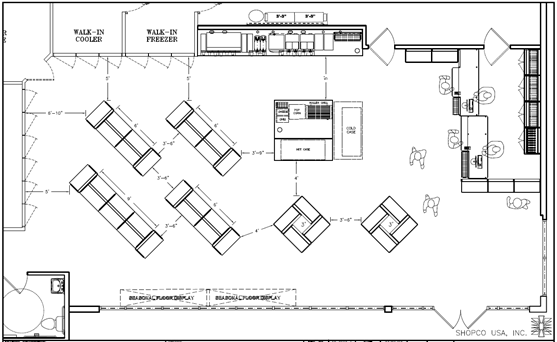Designing a Grocery Store Floor Plan for Increased Customer Satisfaction
By Abu Rizal at: May 09, 2020
A grocery store floor plan is a layout of the store that is designed to optimize the shopping experience for customers.
It includes the placement of products, aisles, checkouts, and other key elements of the store.
A well-designed floor plan can help increase sales and improve customer satisfaction.
Aisle Placement
The placement of aisles in a grocery store is crucial for customer convenience and for maximizing sales.
Aisles should be laid out in a logical and easy-to-navigate manner, with similar products grouped together.
For example, produce, dairy, and meat products should be placed together in the same area.
This makes it easy for customers to find what they are looking for and encourages them to explore other products in the same area.
Checkout Placement
The placement of checkouts is also important in a grocery store floor plan. Checkouts should be placed near the store's entrance and exit to make it easy for customers to pay for their purchases.
This can help reduce congestion in the store and improve the overall customer experience.
Product Placement
The placement of products on the store's shelves is also important. Products should be placed at eye level and at a height that is easy for customers to reach.
This can help increase sales and make it easier for customers to find what they are looking for.
Additionally, products that are on sale or are new should be placed in prominent locations to attract customers' attention.
Mini Grocery Floor Plan
Introduction
A mini grocery store is a small-scale retail outlet that specializes in selling a limited selection of food and household items.These stores are typically found in urban areas, residential neighborhoods, or in areas with limited access to larger supermarkets.
A well-designed mini grocery floor plan can help to maximize the use of space and improve the shopping experience for customers.
Layout
The layout of a mini grocery store should be designed to make it easy for customers to find what they need.
The store should be divided into different sections, such as a produce section, a bakery section, and a meat and dairy section.
Each section should be clearly marked and easy to navigate.
The entrance of the store should be located near the cash registers, so that customers can quickly check out when they are ready to leave.
The store should also have aisles that are wide enough for customers to move around comfortably, and for carts and wheelchairs to pass through easily.
Shelving and Display
Shelving and display options should be chosen to maximize the visibility of products and to make it easy for customers to find what they are looking for.Products should be arranged in a logical order, with similar items grouped together.
For example, all canned goods should be placed in the same area, rather than being scattered throughout the store.
Lighting is also an important aspect of the mini grocery floor plan.
Adequate lighting should be provided to ensure that products are well-lit and easy to see.
This will help to create a welcoming and attractive shopping environment.
Designing a mini grocery floor plan that is functional and easy to navigate can help to improve the shopping experience for customers and increase sales.
By focusing on layout, shelving and display, and lighting, you can create a store that is both attractive and efficient.
Grocery Store Layout Template
A grocery store layout template typically includes a floor plan of the store, including the placement of shelves, aisles, displays, check-out counters, and other fixtures.It also includes information on traffic flow patterns, zoning areas for different types of products, and the location of key departments such as produce, meat, and bakery.
The template may also include information on lighting, signage, and other design elements that help to create a cohesive shopping experience for customers.
Grocery Store Layout Map
A grocery store layout map is a diagram or plan that shows the arrangement of the different departments and sections within a grocery store.This can include areas for produce, meat, dairy, bakery, frozen foods, and more.
The layout map may also show the location of aisles, check-out lanes, and customer service areas.
The goal of the layout map is to make it easy for customers to find what they need and for store employees to quickly locate products for restocking.
Conclusion
A well-designed grocery store floor plan can greatly impact the customer experience and increase sales.By placing aisles, checkouts, and products in a logical and convenient manner, grocery stores can create an environment that is easy to navigate and encourages customers to explore more of the store.
This can lead to higher sales, more satisfied customers, and ultimately, a more successful business.













